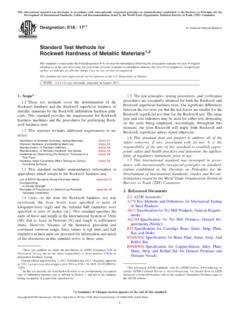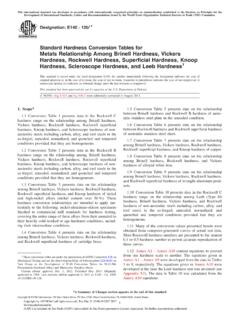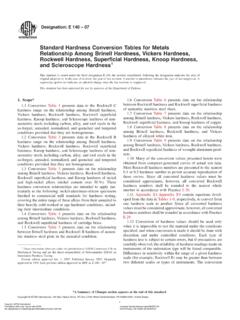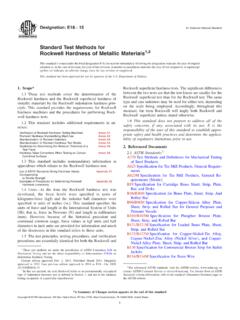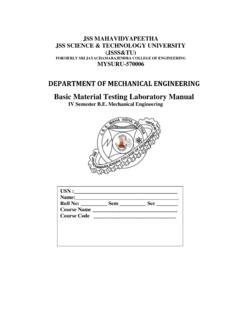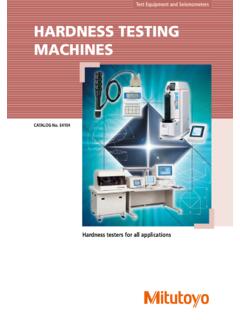Transcription of Standard Test Methods for Vickers Hardness and Knoop ...
1 Designation: E92 17 Standard Test Methods forVickers Hardness and Knoop Hardness of MetallicMaterials1 This Standard is issued under the fixed designation E92; the number immediately following the designation indicates the year of originaladoption or, in the case of revision, the year of last revision. A number in parentheses indicates the year of last reapproval. A superscriptepsilon ( ) indicates an editorial change since the last revision or Standard has been approved for use by agencies of the Department of Scope* These test Methods cover the determination of theVickers Hardness and Knoop Hardness of metallic materials bythe Vickers and Knoop indentation Hardness principles.
2 Thisstandard provides the requirements for Vickers and Knoophardness machines and the procedures for performing Vickersand Knoop Hardness This Standard includes additional requirements in an-nexes:Verification of Vickers and Knoop Hardness Testing MachinesAnnex A1 Vickers and Knoop Hardness Standardizing MachinesAnnex A2 Standardization of Vickers and Knoop IndentersAnnex A3 Standardization of Vickers and Knoop Hardness Test BlocksAnnex A4 Correction Factors for Vickers Hardness tests Made onSphericaland Cylindrical SurfacesAnnex This Standard includes nonmandatory information in anappendix which relates to the Vickers and Knoop hardnesstests.
3 Examples of Procedures for Determining Vickers andKnoop Hardness UncertaintyAppendix This test method covers Vickers Hardness tests madeutilizing test forces ranging from 10-3N to N(1 gf to 120 kgf), and Knoop Hardness tests made utilizing testforces from 10-3N to N (1 gf to 2 kgf). Additional information on the procedures and guidancewhen testing in the microindentation force range (forces 1kgf) may be found in Test MethodE384, Test Method forMicroindentationHardness of When the Vickers and Knoop Hardness testswere developed, the force levels were specified in units ofgrams-force (gf) and kilograms-force (kgf).
4 This standardspecifies the units of force and length in the InternationalSystem of Units (SI); that is, force in Newtons (N) and lengthin mm or m. However, because of the historical precedent andcontinued common usage, force values in gf and kgf units areprovided for information and much of the discussion in thisstandard as well as the method of reporting the test resultsrefers to these The Vickers and Knoop Hardness numbers were originallydefined in terms of the test force in kilogram-force (kgf) and the surfacearea or projected area in millimetres squared (mm2). Today, the hardnessnumbers are internationally defined in terms of SI units, that is, the testforce in Newtons (N).
5 However, in practice, the most commonly usedforce units are kilogram-force (kgf) and gram-force (gf). When Newtonunits of force are used, the force must be divided by the conversion The test principles, testing procedures, and verificationprocedures are essentially identical for both the Vickers andKnoop Hardness tests . The significant differences between thetwo tests are the geometries of the respective indenters, themethod of calculation of the Hardness numbers, and thatVickers Hardness may be used at higher force levels thanKnoop While Committee E28 is primarily concerned with metallicmaterials, the test procedures described are applicable to other materials may require special considerations, for example seeC1326andC1327for ceramic Standard does not purport to address all of thesafety concerns, if any, associated with its use.
6 It is theresponsibility of the user of this Standard to establish appro-priate safety and health practices and determine the applica-bility of regulatory limitations prior to international Standard was developed in accor-dance with internationally recognized principles on Standard -ization established in the Decision on Principles for theDevelopment of International Standards, Guides and Recom-mendations issued by the World Trade Organization TechnicalBarriers to Trade (TBT) Referenced Standards:21 These test Methods are under the jurisdiction of ASTM CommitteeE28onMechanicalTesting and is the direct responsibility of edition approved April 1, 2017.
7 Published May 2017. Originallyapproved in 1952. Last previous edition approved in 2016 as E92 16. referenced ASTM standards, visit the ASTM website, , orcontact ASTM Customer Service at ForAnnual Book of ASTMS tandardsvolume information, refer to the Standard s Document Summary page onthe ASTM website.*A Summary of Changes section appears at the end of this standardCopyright ASTM International, 100 Barr Harbor Drive, PO Box C700, West Conshohocken, PA 19428-2959. United StatesThis international Standard was developed in accordance with internationally recognized principles on standardization established in the Decision on Principles for theDevelopment of International Standards, Guides and Recommendations issued by the World Trade Organization Technical Barriers to Trade (TBT)
8 C1326 Test Method for Knoop Indentation Hardness ofAdvanced CeramicsC1327 Test Method for Vickers Indentation Hardness ofAdvanced CeramicsE3 Guide for Preparation of Metallographic SpecimensE6 Terminology Relating to Methods of Mechanical TestingE7 Terminology Relating to MetallographyE29 Practice for Using Significant Digits in Test Data toDetermine Conformance with SpecificationsE74 Practice of Calibration of Force-Measuring Instrumentsfor Verifying the Force Indication of Testing MachinesE140 Hardness Conversion Tables for Metals RelationshipAmong Brinell Hardness , Vickers Hardness , RockwellHardness, Superficial Hardness , Knoop Hardness , Sclero-scope Hardness , and Leeb HardnessE175 Terminology of MicroscopyE177 Practice for Use of the Terms Precision and Bias inASTM Test MethodsE384 Test Method for Microindentation Hardness of Mate-rialsE691 Practice for Conducting an Interlaboratory Study toDetermine the Precision of a Test Standards:3 ISO 6507-1 Metallic Materials Vickers Hardness Test Part 1.
9 Test MethodISO/IEC 17011 Conformity Assessment General Require-ments for Accreditation Bodies Accrediting ConformityAssessment BodiesISO/IEC 17025 General Requirements for the Competenceof Testing and Calibration Laboratories3. Terminology and of Terms For the Standard definitions ofterms used in this test method, see Hardness , n the Hardness as evaluatedfrom measurements of area or depth of the indentation made byforcing a specified indenter into the surface of a material underspecified static loading Hardness number,HK,n the calculated resultfrom a Knoop Hardness test, which is proportional to the testforce applied to the Knoop indenter divided by the projectedarea of the permanent indentation made by the indenter afterremoval of the test The projected area of the permanentindentation made by the Knoop indenter is calculated basedpartly on the measured length of the long diagonal of theprojected area of the Hardness test, n an indentation test in which aKnoop rhombic-based pyramidal diamond indenter havingspecified edge angles, is forced under specified conditions intothe surface of the test material, and, after removal of the testforce.
10 The length of the long diagonal of the projected area ofthe indentation is measured to calculate the Knoop Hardness number,HV,n the calculated resultfrom a Vickers Hardness test, which is proportional to the testforce applied to the Vickers indenter divided by the surfacearea of the permanent indentation made by the indenter afterremoval of the test The surface area of the permanent in-dentation made by the Vickers indenter is calculated basedpartly on the measured mean length of the two diagonals of theprojected area of the Hardness test, n an indentation test in whicha Vickers square-based pyramidal diamond indenter havingspecified face angles is forced under specified conditions intothe surface of the test material, and, after removal of the testforce, the lengths of the two diagonals of the projected area ofthe indentation are measured to calculate the Vickers of Terms Specific to This , n to bring in conformance to aknown Standard through verification or Hardness test, n a Hardness test,normally in the Vickers or Knoop scales, using test forces inthe range of 10-3to N (1 to 1000 gf).
